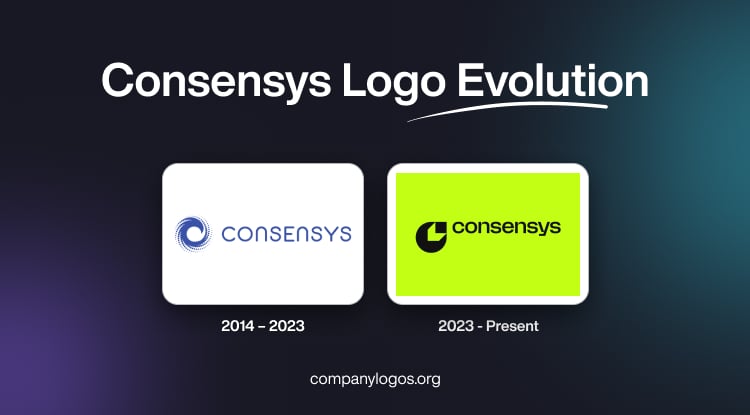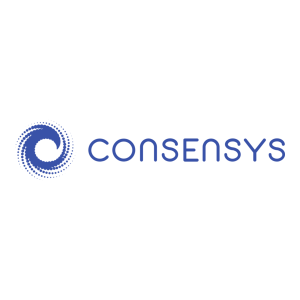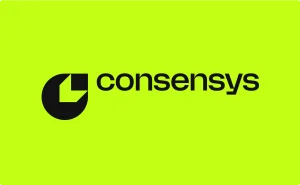
ConsenSys is a leading blockchain technology company that builds software, infrastructure, and tools for the Ethereum ecosystem and the broader Web3 landscape. It was founded in 2014 by Joseph Lubin, who was one of the co-founders of Ethereum. Consensys, which originated as ConsenSys, an abbreviation of “Consensus Systems”, is based in Brooklyn, New York, and has become one of the most influential organisations driving blockchain adoption worldwide.
From its inception, ConsenSys has been dedicated to realising the vision of a decentralised, user-owned internet. It develops products that empower individuals, developers, and enterprises to build and interact with decentralised applications. Among its most recognised creations are MetaMask, the world’s most widely used Web3 wallet; Infura, a scalable blockchain infrastructure provider; and Truffle Suite, a leading developer framework for Ethereum smart contracts.
The Consensys logo has undergone one change since its inception. It reflects the company’s journey and evolution from a pioneering Ethereum software incubator to an influential blockchain and Web3 technology leader. The article explores the evolution of the Consensys logo, among other details of the company.
The Genesis of the Consensys Logo (2014 – 2023)
The original Consensys logo featured a dynamic swirl of blue dots forming a spiral to convey a sense of motion and fluidity. Here, each dot or circle symbolised individuals that comprised the Web3 ecosystem. It also represented the concept of consensus, wherein the dots or circles symbolised nodes forming agreement in a network. The spiral dot logo remained a recognisable visual identifier for Consensys as it expanded within the Ethereum and blockchain ecosystem. The wordmark “CONSENSYS” in uppercase was written using a clean and modern sans-serif typeface.

(2023 – Present)
The most radical change to the logo came in June 2023, when Consensys launched a new brand identity. Created in collaboration with Wolff Olins, the logo marked the first comprehensive rebranding. It was designed to position Consensys at the forefront of Web3 mainstream adoption.
The new logo features a graphical letter “c” that can be interpreted both as a two-dimensional symbol and a three-dimensional block extending upward. The colours of the logo are neon or lime green and black. The graphical element is accompanied by the brand name in uppercase using a modern, clean sans-serif typeface in black. Overall, the logo is set against a neon green background.

The Elements of the Consensys Logo
Font
The Consensys logotype uses a clean, custom sans-serif typeface in lowercase that is characterised by geometric precision and balanced spacing. The typeface is often identified with modernist and tech-focused brands.
Colour
The latest Consensys logo is designed in monochrome (black and white) and conveys maturity and inclusivity.
The History of Consensys
ConsenSys, which is officially known as ConsenSys Software Inc., was founded in 2014 by Joseph Lubin. He was one of the co-founders of Ethereum and built the company with the mission to build tools, applications, and infrastructure that would support a decentralised web powered by Ethereum. Based in Brooklyn, New York, the company emerged as one of the earliest and most influential organisations in the blockchain space. During its early years between 2014 and 2016, ConsenSys operated as a venture production studio. It developed and incubated multiple Ethereum-based projects simultaneously.
Among its key creations was MetaMask, which was a browser extension that became the primary gateway for users to interact with decentralised applications. The other creations included Infura, a powerful infrastructure platform that provided scalable Ethereum and IPFS access for developers; uPort, a decentralised identity solution; and Truffle Suite, a widely used development framework for Ethereum smart contracts. These innovations laid the groundwork for the mass adoption of Ethereum technology and made blockchain development more accessible worldwide.
Between 2017 and 2019, especially during the height of the Initial Coin Offering (ICO) boom, ConsenSys rapidly expanded its global presence. It grew to over 1,200 employees across more than 30 countries. The company entered partnerships with major corporations such as Microsoft, Deloitte, and J.P. Morgan and launched initiatives like ConsenSys Enterprise to support blockchain adoption in traditional industries.
It also introduced ConsenSys Academy, a training platform designed to educate developers in blockchain technology. However, the downturn of the crypto market in late 2018 prompted a major restructuring. This marked the company’s transition into “ConsenSys 2.0”, where the company shifted focus from broad incubation efforts to a more sustainable, product-driven business model.
From 2020 to 2021, ConsenSys redefined its organisational structure by separating its software business into ConsenSys Software Inc. and its venture arm into ConsenSys Mesh. The separation of these entities allowed each of them to focus on its respective goals. This restructuring led to significant investment, including a $200 million funding round in 2021 that valued the company at $3.2 billion.
It was backed by prominent investors such as J.P. Morgan, Mastercard, and UBS. In the same year, ConsenSys acquired Quorum, J.P. Morgan’s enterprise blockchain platform. This led to the strengthening of its suite of Ethereum-based solutions and cemented its position as a leader in blockchain innovation.
Between 2022 and 2025, ConsenSys continued to expand its influence across the Web3 ecosystem. For instance, its MetaMask grew to over 30 million monthly active users, and Infura became a core infrastructure provider for decentralised applications worldwide. In 2022, the company raised an additional $450 million in a Series D funding round, which elevated its valuation to over $7 billion.
ConsenSys also began focusing on layer-2 scaling technologies, decentralised finance (DeFi), non-fungible tokens (NFTs), and enterprise blockchain solutions. These aligned closely with the Ethereum 2.0 proof-of-stake transition. ConsenSys stands as a central pillar in the Ethereum and Web3 ecosystem and has played a crucial role in driving the global adoption of blockchain technology.
Interesting Facts About Consensys
- ConsenSys was founded in 2014 by Joseph Lubin, who happens to be one of the co-founders of Ethereum, the second-largest blockchain in the world. His dual role made ConsenSys one of the earliest companies to get deeply embedded in the Ethereum ecosystem.
- In its early years, ConsenSys operated as a venture production studio. It incubated dozens of Ethereum-based startups simultaneously. This structure helped launch some of the most influential Web3 tools used today.
- ConsenSys is the company behind MetaMask, which is the world’s most popular crypto wallet and gateway to decentralised applications (dApps).
- ConsenSys built Infura, a developer platform that provides scalable access to Ethereum and IPFS. Many major decentralised applications, such as Uniswap and OpenSea, rely on Infura to connect to the blockchain without running their own nodes.
- ConsenSys has formed partnerships with global giants like J.P. Morgan, Mastercard, and UBS. It helped bridge the gap between traditional finance and decentralised technology. Its acquisition of Quorum, J.P. Morgan’s enterprise blockchain platform, strengthened this relationship further.
- The company played a vital role in supporting Ethereum’s transition to Proof-of-Stake (Ethereum 2.0) by providing infrastructure and tools that helped developers and validators during the upgrade process.
- To grow the blockchain developer community, ConsenSys launched ConsenSys Academy. It offers structured blockchain education and certification programmes to students and professionals worldwide.
- ConsenSys has attracted investment from top-tier institutions. It raised $200 million in 2021 and $450 million in 2022, with a valuation exceeding $7 billion. The investors include Microsoft, SoftBank, J.P. Morgan, and Temasek.
- ConsenSys was a founding member of the Enterprise Ethereum Alliance (EEA), which is an organisation focused on helping businesses adopt Ethereum-based technologies for real-world applications.
- The Truffle Suite, another major product of ConsenSys, is one of the most popular development frameworks for Ethereum smart contracts. It simplifies blockchain development and testing and makes it easier for new developers to build dApps.
- ConsenSys operates with a global and largely remote workforce. Its employees are spread over 30 countries and reflect the decentralised ethos of the blockchain world.
- By promoting Ethereum’s shift to a proof-of-stake model, ConsenSys helped drastically reduce the network’s energy consumption by nearly 99.9%.
- ConsenSys projects like uPort were among the first to explore decentralised identity (DID). These allowed users to control their digital identities securely without relying on centralised platforms.
- The company’s venture and incubation arm, ConsenSys Mesh, continues to fund and support emerging Web3 startups across DeFi, NFTs, and digital infrastructure. This way, Consensys has extended its influence throughout the blockchain space.
- True to Ethereum’s philosophy, many of the tools and platforms developed by Consensys are open source. This allowed global developers to contribute, improve, and innovate freely.
Finally
The evolution of the Consensys logo is a testament to the company’s journey, that is, how it evolved from a core technology incubator to a visionary leader in blockchain. The logo design inspires participation, ownership, and creativity in the development of Web3. It stands today as a visual mark as well as a representation of ConsenSys’s enduring commitment to building an open, decentralised future.